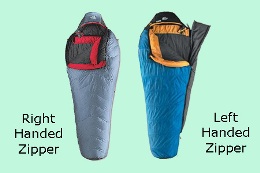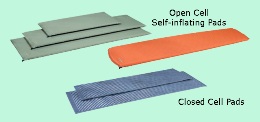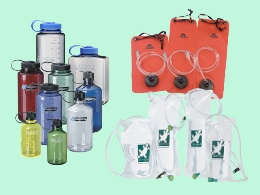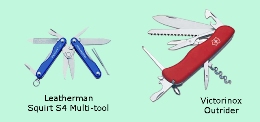| Personal Gear |
Sleeping Bags
"Down" vs "Synthetic" is always the dilemma. Recently manufacturers
start producing hybrid sleeping bags, which make use of both Down Feathers
and Synthetic Fibers.
I am a big fan of Down because it's 50% lighter, more compact,
better at regulating temperature, lasts longer, easier to clean .... and
the "good" list just goes on and on.
The only drawback of Down is that you lose the insulating capacity
if it gets wet. If you are travelling to high-humidity areas, there
are many ways to protect your Down bag from getting wet. My recommendation
is to invest in a good "Down" bag with a water-resistant shell.
|
| |

|
|
Pay attention to what side of zipper
is on the sleeping bag.
|
|
Sleeping Pads
People may think that sleeping pad is only for comfort. Actually, it
is designed to insulate you from the heat-sucking ground. There are "Open"
and "Closed" cell pads in the market.
Open cell is basically an air mattress with collapsible material built inside.
It is usually heavier but more compact when folding up. The drawback is that air
will leak through seams and small puncture holes. You need to bring along a
repair kit.
Closed cell is generally a foam based mattress. It is lighter but very bulky
to carry. Both will do a good job in insulating you and giving you comfort.
My recommendation is to invest in a good "Open" cell and a repair kit, such
as a Thermarest.
|
| |

|
|
|
Pads come in different sizes and thickness
|
|
Headlamps / Flashlight
Unlike flashlights, headlamps give us back our mighty free hands. The only
drawback is that sometimes when you are talking to someone, you will accidentally
blinds them by the light.
LED headlamps have come into the market in recent years and are very popular.
They are very light and compact. They consume much less energy (battery) for the
same amount of light output. My recommendation is to invest in a small LED headlamp,
such as Tikka Plus made by Petzl.
|
|
|
| |

|
|
Wide-mouth Nalgene are very useful as storage
containers, and most water bladders will
last 2 - 3 years on average.
|
|
Water bottle vs Water Bladder
The Nalgene bottle has to be one of the greatest innovation in the camping
equipment industry. They are invincibly durable and can sustain temperatures
ranging from -135C to 135C. Almost every hiker and backpacker has or has had
one. They now offer different colours for our convenience.
A Water Bladder is less durable, but their advantages over bottles
are way beyond imagination. It bears virtually no weight. It is collapsible.
It allows you to drink water in an easier way. It doesn't split, and it
generally holds more water than a standard nalgene.
That being said, even if I use my bladder every trip, I still bring along a Nalgene.
They are useful in collecting water from creek, making a hot water bottle and
for waterproof storage. I have all my first aid kit items fit into a
1L Nalgene bottle.
My recommendation is to get both a 2+ Litres water bladder, and a non-standard coloured
1 Litre wide mouth nalgene. You never know when they come in handy.
|
| |

|
|
Are they that useful ?
Or just gadgets you don't need ?
|
|
Multi-tool / Swiss Army Knife
There are gazillion models of Multi-tools and Swiss Army Knives that we
can choose from. Any tool that you can think of, manufacturers probably
had already made a miniature version of it.
Most of them already come with standard features such as can openers, tweezers,
screw drivers and bottle openers. Choose one with a locking blade and a pair of
small scissors. I consider all other fancy add-ons are simply unnecessary weight.
A few models that I will recommend include Victorinox Outrider Lockblade Knife,
Leatherman Micra and Letterman Squirt P4 Mlti-tool.
|
|